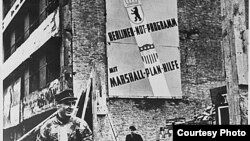Seventy years ago today, then Secretary of State George Marshall unveiled his “European Recovery Program”, which became known as "The Marshall Plan," during a speech at Harvard University.
In 1947, Europe lay in ruins and on the brink of famine after years of fighting to stop German leader Adolf Hitler’s Nazi march across the continent.
Marshall proposed funneling $13 billion to rebuild the devastated continent, not only in an act of global altruism, but according to historians, to stop the spread of Soviet communism.
The plan promoted European economic integration and federalism, and created a mixture of public organization of the private economy similar to that in the domestic economy of the United States. This reorganization of the European economy paid off politically and economically.
Containment
The roots of Marshall’s thinking was that communism is more likely to take hold in countries weakened by the war, and over time the price of reconstruction would amount to pennies if the Soviet government was blocked from spreading its sphere of influence.
Just a few months before, in March, President Harry Truman in essence unveiled that same idea to the U.S. Congress in what became known as the Truman Doctrine.
Countries that participated in the plan included Austria, Belgium, Denmark, France, West Germany, Great Britain, Greece, Iceland, Italy, Luxembourg, the Netherlands, Norway, Sweden, Switzerland, and Turkey.
The Soviet Union was suspicious of the plan and pressured its Eastern European allies to reject all U.S. assistance. The pressure proved successful and none of the Soviet satellites participated in the Marshall Plan. The Soviet-controlled press claimed the American program was “a plan for interference in the domestic affairs of other countries.”
The Marshall Plan successfully sparked economic recovery in the West, meeting its objective of “restoring the confidence of the European people in the economic future of their own countries and of Europe as a whole.”
And although the United States and the Soviet Union fought on the same side during the war, post-war animosity and suspicions grew, leading to a decades long so-called Cold War.







